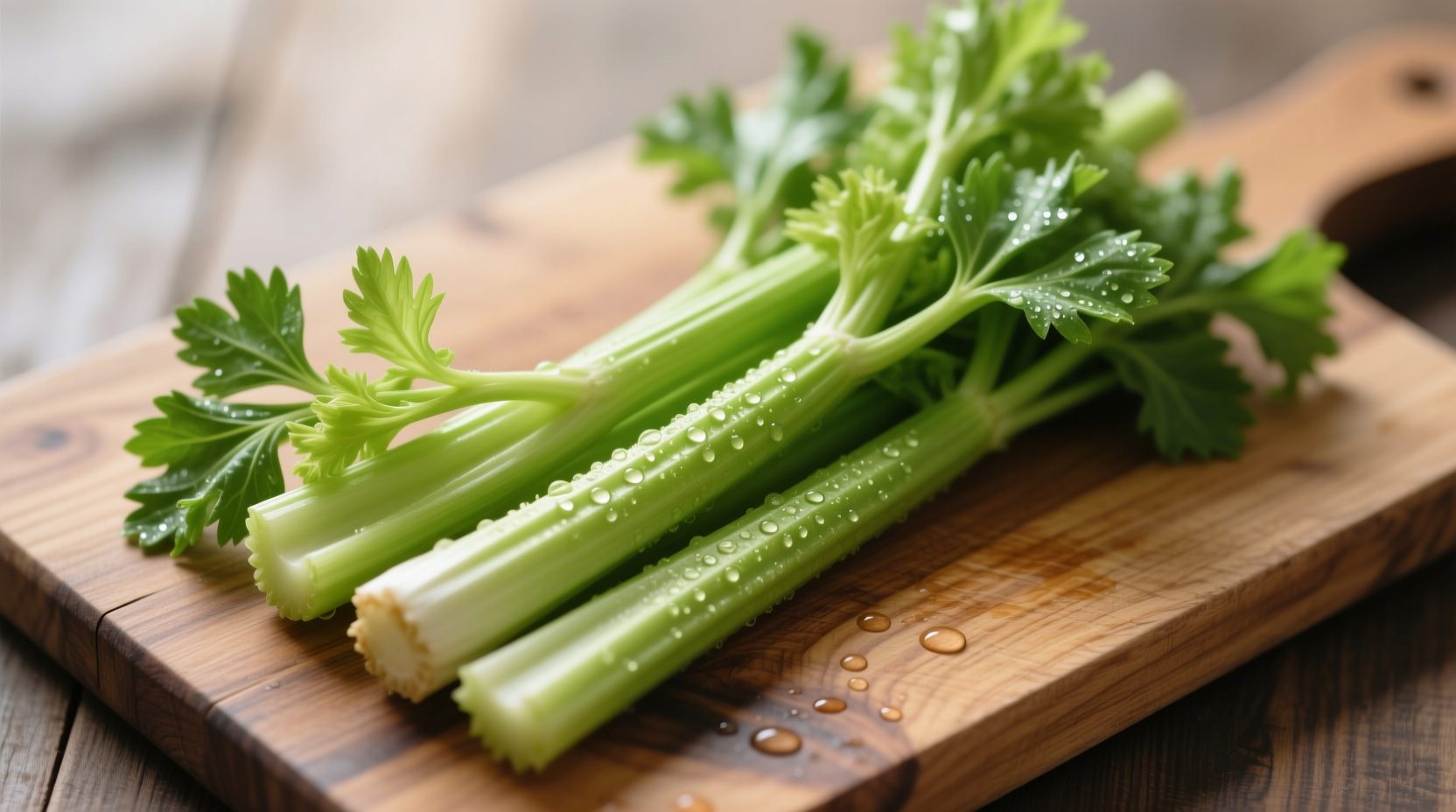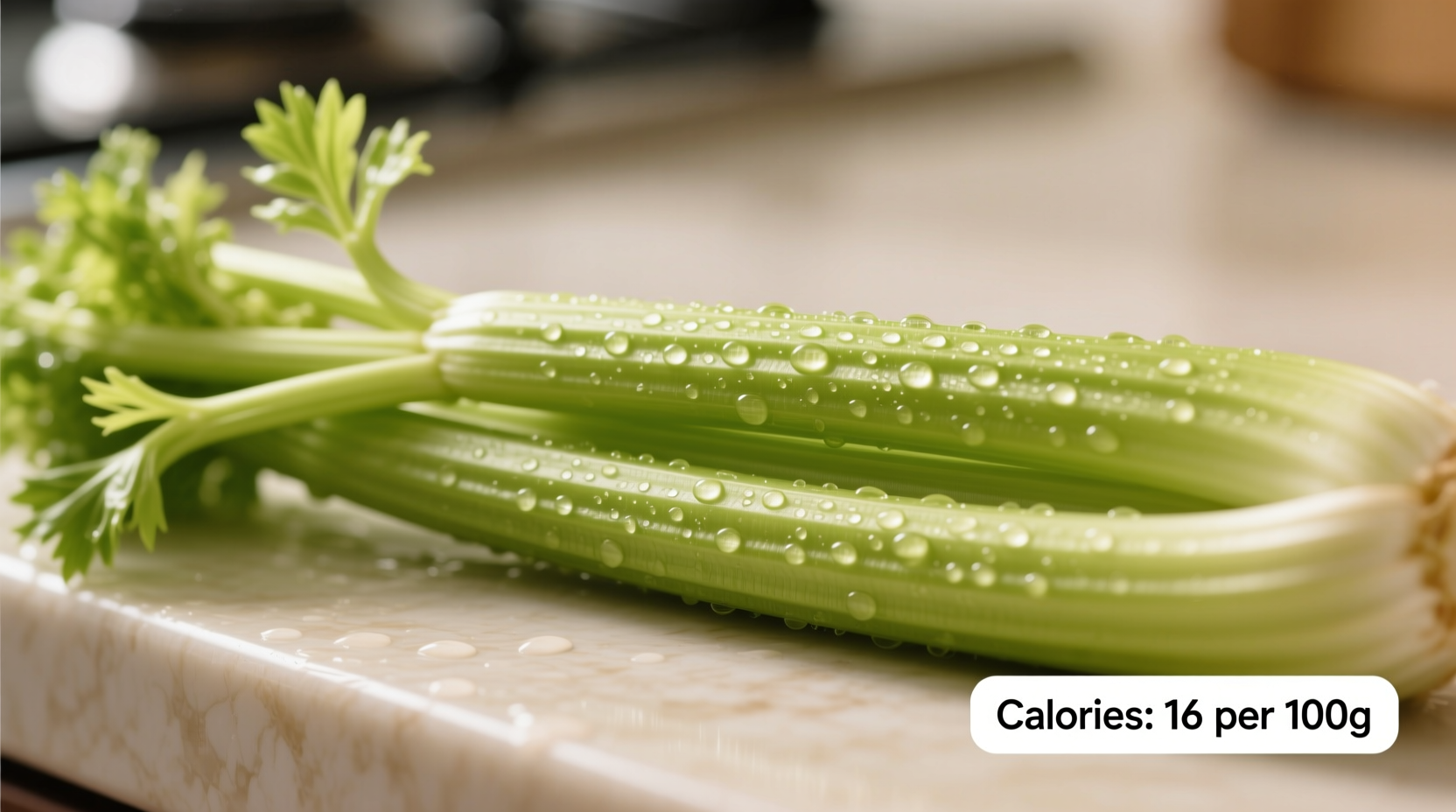When you're tracking your daily calorie intake or exploring low-calorie snack options, understanding the precise nutritional value of celery becomes essential. This crisp, refreshing vegetable has long been a staple in weight management diets, but separating fact from fiction requires accurate data from reliable sources.
Exact Calorie Count and Nutritional Breakdown
According to the USDA FoodData Central database, celery's nutritional profile is remarkably consistent across varieties. The standard measurements provide clear guidance for meal planning:
| Celery Serving Size | Calories | Carbohydrates | Fiber | Water Content |
|---|---|---|---|---|
| 1 medium stalk (40g) | 6 kcal | 1.2g | 0.6g | 95% |
| 1 cup chopped (100g) | 16 kcal | 3g | 1.6g | 95% |
| 2 cups chopped (200g) | 32 kcal | 6g | 3.2g | 95% |
This data from the USDA FoodData Central (accessed September 2025) represents the most current nutritional analysis available. The consistency in water content (approximately 95%) explains celery's exceptionally low caloric density compared to other vegetables.
Why Celery Is Exceptionally Low in Calories
Celery's remarkably low calorie count stems from its biological composition. Unlike starchy vegetables such as potatoes or corn, celery evolved as a water-storing plant rather than an energy-storing one. Its structure consists primarily of:
- Nearly 95% water content, providing volume without calories
- Minimal natural sugars (only 1.4g per 100g)
- Low protein content (0.7g per 100g)
- Fiber that contributes to fullness without significant caloric impact
The high water and fiber content creates what nutrition scientists call "dietary volume" - providing substantial mouthfeel and stomach satisfaction with minimal caloric intake. This characteristic makes celery particularly valuable for those managing their weight through volumetric eating strategies.

Debunking the Negative Calorie Myth
The persistent myth that celery has "negative calories" suggests your body burns more energy digesting it than the vegetable provides. While the thermic effect of food (TEF) does require energy for digestion, research published in the Journal of the Academy of Nutrition and Dietetics confirms this effect represents only 5-15% of a food's caloric value.
For celery's 16 calories per 100g, the maximum energy expenditure during digestion would be approximately 2.4 calories - still resulting in a net positive caloric intake. Registered dietitians consistently emphasize that no food creates a true "calorie deficit" through digestion alone.
Practical Applications for Daily Nutrition
Understanding celery's actual caloric value helps you incorporate it effectively into various dietary approaches:
Smart Snacking Strategies
Replace higher-calorie snacks with celery-based options:
- Fill celery stalks with 1 tablespoon of natural peanut butter (adds 95 calories but provides protein and healthy fats)
- Create "ants on a log" with celery, nut butter, and raisins for a balanced snack
- Use celery as a vehicle for hummus (2 tablespoons adds about 70 calories)
Meal Integration Techniques
Chefs and nutritionists recommend these methods to maximize celery's culinary utility:
- Add finely diced celery to tuna or chicken salad to increase volume without significant calorie addition
- Include celery in vegetable broth-based soups for flavor without caloric impact
- Use celery leaves (often discarded) which contain concentrated nutrients and flavor
Contextual Considerations for Celery Consumption
While celery offers nutritional benefits, certain contexts require consideration:
- For individuals with kidney issues: Celery contains moderate potassium (260mg per 100g), which may need monitoring in renal diets
- When following a low-FODMAP diet: Celery contains mannitol, which may trigger symptoms in sensitive individuals
- For those on blood thinners: The vitamin K content (29.6μg per 100g) requires consistent intake to avoid medication interactions
- When seeking significant nutrient density: While low in calories, celery provides minimal protein and fat compared to other vegetables
Comparative Analysis With Common Vegetables
Understanding where celery fits among other vegetables helps with meal planning. The following comparison shows caloric density per 100g:
| Vegetable | Calories | Carbohydrates (g) | Fiber (g) | Water Content |
|---|---|---|---|---|
| Celery | 16 | 3.0 | 1.6 | 95% |
| Cucumber | 15 | 3.6 | 0.5 | 96% |
| Lettuce | 15 | 2.9 | 1.3 | 95% |
| Broccoli | 34 | 7.0 | 2.6 | 91% |
| Carrots | 41 | 9.6 | 2.8 | 88% |
This comparison, based on USDA data, shows celery sits among the lowest-calorie vegetables available. However, vegetables like broccoli provide significantly more nutritional density despite slightly higher calorie counts.
Maximizing Celery's Nutritional Benefits
To get the most from celery while maintaining awareness of its caloric reality:
- Pair with healthy fats: The fat-soluble vitamins in celery (like vitamin K) absorb better when consumed with healthy fats
- Don't discard the leaves: Celery leaves contain higher concentrations of nutrients than the stalks
- Store properly: Keep celery in the refrigerator wrapped in aluminum foil to maintain crispness and nutrient retention
- Consider preparation method: Raw celery maintains all its nutrients, while cooking can reduce certain vitamin levels
Common Misconceptions Addressed
Several myths persist about celery's nutritional properties:
- Myth: Organic celery has fewer calories than conventional
Fact: Organic status doesn't affect caloric content, though it may impact pesticide residues - Myth: Cooking celery significantly increases its calories
Fact: Cooking doesn't add calories unless you add fats or sugars during preparation - Myth: Celery juice has fewer calories than whole celery
Fact: Juicing removes fiber but concentrates natural sugars, potentially increasing caloric density per volume
Practical Calorie Tracking Tips
When incorporating celery into your diet tracking:
- Measure portions consistently - a cup of chopped celery differs significantly from a whole stalk
- Account for any additions like dressings or dips that substantially increase calorie count
- Consider using celery as a partial replacement for higher-calorie ingredients in recipes
- Track celery consumption in food journals to understand its role in your overall dietary pattern











 浙公网安备
33010002000092号
浙公网安备
33010002000092号 浙B2-20120091-4
浙B2-20120091-4